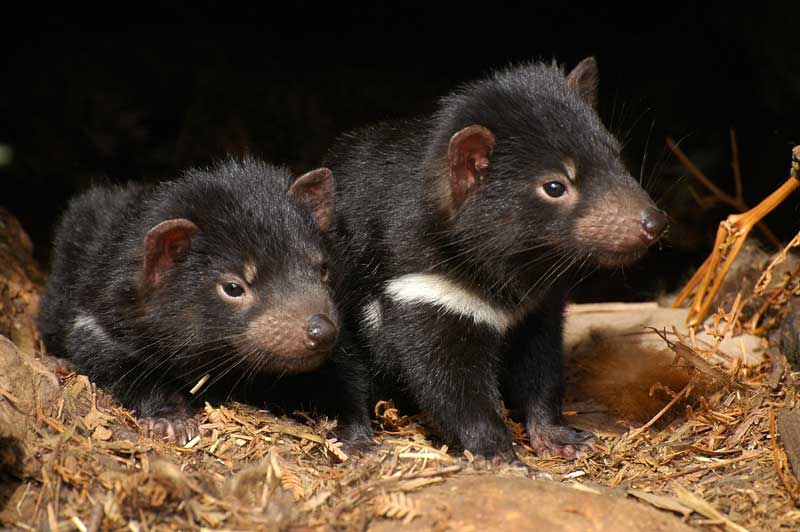
As the name suggests, the Tasmanian devils live across the Tasmanian wilderness, forests, farmlands and coastlines, even in the suburbs. However, with the discovery of their fossils in mainland Australia, it is believed that, the devil became extinct from the mainland some 3,000 years ago, probably due to the adverse weather condition and steadily increasing number of the dingo, which was prevented by Bass Strait from entering Tasmania. They were named by the early European settlers, who called them devils, for their mysterious and unearthly screams, coughs and growls from the dense undergrowths. However, despite their famous gape or yawn, wide jaws and big sharp teeth, they are not really devils, they display their menacing attitude more from fear and uncertainty than from aggression.
Known as the largest surviving carnivorous marsupial, the devils of Tasmania have a thickset, squat build, with relatively longer forelegs, broad head and short, thick tail. The fur is mostly or wholly black, but white markings often occur on the rump and chest, though the wild devils do not have those white patches. Adult male devils are usually larger than adult females. Large males are 25 to 30 inches long with a bushy tail about half that length, weigh up to12 kg and stand about 12 inches high at the shoulder. Due to their comparatively large heads, they have very strong jaws, which they can open up to 80 degrees, allowing them to generate tremendous power to tear meat and crush bones. While the devils have four toes on their hind feet, they have five long toes on their forefeet, out of which four pointing to the front and the fifth coming out from the side, which helps them to hold food. Surprisingly, the devils can run up to 13 km per hour (8.1 mph) for short distances and can also swim, even in icy waterways. Like other marsupials, the devils store body fat in their tails and the ano-genital scent gland at the base of its tail is used to mark the ground behind the animal with its strong, pungent scent.

The Tasmanian devil is a nocturnal animal, spending the days in dense bush or in dens. They are the world's largest carnivorous marsupial and eat birds, snakes, fish, insects, small animals, even dead carcasses and can eliminate all traces of a carcass of a smaller animal, including the bones and the fur.
The female devils become mature enough to breed typically in their second year and they typically mate once a year, between February and May. Males fight over females in the breeding season and females mate with the dominant male. However, as they are polygamous, the females mate with several males, if not guarded after mating and males also reproduce with several females during a season. To avoid probable unwanted disturbances from the other mate devils, they prefer to mate peacefully in secluded and sheltered locations, both during the day and night.

After a gestation period of 21 days, the mother devils give birth to around 30 pink and hairless pups or imps, who competes with each other as they move from the vagina of their mother with a sticky flow of mucus to the pouch.
The pouch of the female devil opens to the rear and has only four nipples. Naturally, only the lucky four have the chance to survive, while the others die without nourishment. The lucky babies, developing in the mother’s pouch usually emerge after about four months and are generally weaned by the sixth month and on their own by the eighth.

Though in the wild Tasmanian devils live up to six years, the greatest recent threat to devils across Tasmania is the Devil Facial Tumour Disease, a rare contagious cancer that causes large lumps to form around the mouth and head of the animal, making it hard for it to eat and eventually starves to death.